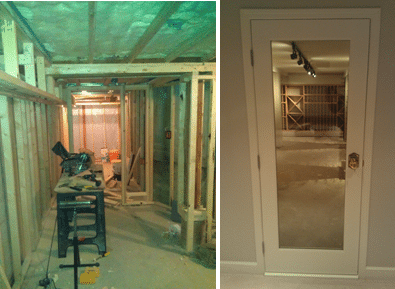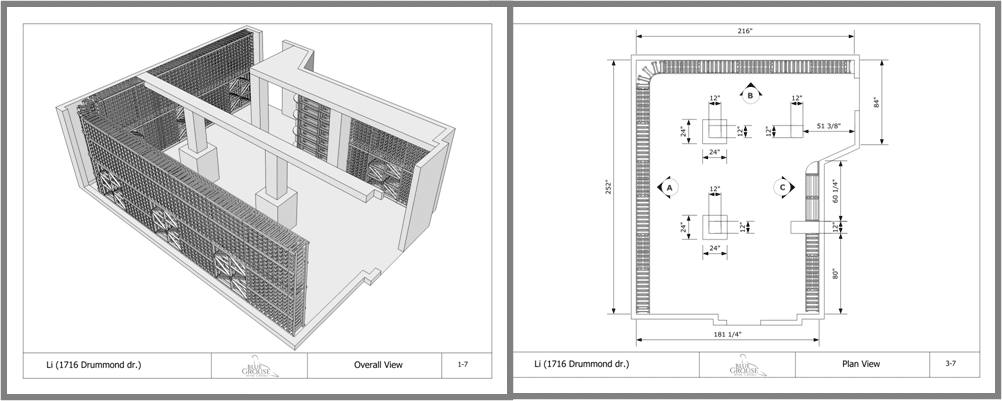The collection of every wine lover, whether he has few, a hundred bottles or more, deserves to be displayed elegantly in a wine cellar. One’s residential wine cellar must be climate-controlled to protect wine from being ruined by harmful external factors such as light and vibration.
The demand for wine cellars is on the rise in many parts of the world because of their important role in preserving wine’s quality and the fact that they add resale value to your home. Shawn Li is one of the residents in Vancouver, Canada who wanted to have both a functional and beautiful wine cellar in his own home.
The extensive experience and skillful hands of the Blue Grouse Wine Cellars design and installation team resulted in another remarkable wine cellar renovation project in Vancouver, Canada.
As a standard operating procedure, the custom wine cellar design process started with interviewing the client to know every detail of his space, wine storage, and aesthetic requirements. Since Blue Grouse’s installer and the owners didn’t speak the same language, this process was not easy. However, the nanny and a friend of theirs performed the role of the translator, so Blue Grouse was able to know exactly what the owners wanted their wine cellar to look like.
Wine Cellar Construction – Achieving Proper Wine Storage

As a solution to the unleveled concrete floor, level bases with scribed trim were built so that the wine racks would have a platform to stand on. If the owner wants to level the floor sometime in the future, the existing wine racking need not be modified or removed.
The ideal environment for wine has a temperature of 55-60 degrees Fahrenheit and relative humidity of 50-70 percent. Proper wall insulation and vapor barrier installation are required to meet these conditions.
A tightly sealed wine cellar door is also important in preventing external factors and temperature fluctuations from ruining the wines. Blue Grouse Wine Cellars used a door of exterior grade with weather stripping to keep the cool air in the wine cellar.
Written by Holly Peters - Custom Wine Cellars Vancouver Comments Off on Wine Storage & Wooden Wine Racks in Vancouver, Canada
Having a residential custom wine cellar built in your home in Vancouver, Canada is one of the best decisions you can make for your beloved wine collection. Your wines need the best conditions in order to mature tastefully. The ideal humidity and temperature levels for wine storage can be met if you have a home wine cellar in Canada with a good wine cellar cooling system installed.
Wine racks are an essential part of a custom wine cellar in Canada. Wine racks can be made from various kinds of materials, but the most popular are wooden wine racks in Vancouver, Canada. Wooden wine racks are also considered to be an exceptionally beautiful kind.
There are many approaches to having wine racks in Canada, which include having a carpenter build them, buying wine rack kits, or having a wine rack company design and construct them. Learn about each option by reading through this article.
Wooden Wine Racks in Canada Built by a Carpenter
Some wine collectors choose to have their wine racking built by a carpenter. This is one of the most common approaches to wine racking. Generally, carpenters who build wine racks are highly dependent on a detailed design that you provide them. The problem is, most carpenters have no idea of the size of wine bottles, nor about how to size the openings correctly. There have been many cases wherein a carpenter built the openings of the individual racks too big for the bottles. Carpenters, no matter how good they are, are generally very dependent on the design provided to them, and if there is something wrong with the details of the design (e.g. dimensions and measurements), the construction will be faulty.
Written by Holly Peters - Custom Wine Cellars Vancouver Comments Off on Basic Construction Specifications when Building a Custom Wine Cellar in Canada
Planning to have a custom wine cellar in Canada? Whether it’s a commercial or residential wine cellar, there are specifications you need to follow in order to make sure that your wine storage room will function properly. Here are a few construction specifications for wine cellars in Vancouver:
1. Cellar Wall & Ceiling Frame
When building a wine cellar, make sure that the wall framing is built using standard 2×4 or 2×6 construction methods. It’s also imperative that you know and follow the building codes in your area. If metal studs will be used, be sure to place at least 5 rows of nailers horizontally in between studs at the right heights, or attach firing strips on the left edge of the metal studs. These nailers or strips are where the wine racks will be attached, so these have to be very durable.
2. Wine Cellar Vapor Barrier & Insulation
You need to install a vapor barrier and insulation to your custom wine cellar in Vancouver if it is to be chilled. Vapor barriers and insulation make sure that the cold inside the wine storage room is kept inside and remains constant.
In creating vapor barriers, you first need to apply 6-mill plastic sheeting to the warm side of the wine cellar walls. You must apply a vapor barrier on the outside walls and ceiling of your custom wine cellar. Make sure that the seams are taped and sealed before the walls are closed.
In cases wherein it’s not possible to apply a vapor barrier on the outside of the studs or joists, you must apply plastic inside the wine cellar to the outside walls. What most people commonly do is wrap the entire interior of their residential wine cellar in Canada leaving the plastic loose inside the stud cavity. In between the studs, you can apply insulation. It is imperative that all of the cellar’s walls and ceiling are completely wrapped in plastic so that vapor barrier is effective. Insulation for the walls should be R13, or greater while R19 to R30 is best for the ceiling.
3. Custom Wine Cellar Doors
If your custom wine cellar is to be chilled, the exterior grade of your wine cellar door should be solid core 1.75”. You may also choose to have glass on the cellar door; if so, you must use sealed insulated glass. To prevent warm air from penetrating the door, exterior grade weather stripping is also required.
4. Residential Wine Cellar Lighting
The best type of lights are LED lights, but if you want to use recessed cans and halogen lighting accents, you must have a good wine cellar cooling unit to remove the heat generated by these lights out from the cellar. It is important to consider also that lighting that emits more heat also consumes more power.
Written by Holly Peters - Custom Wine Cellars Vancouver Comments Off on Wine Storage Essentials for the Wine Collector in Vancouver, Canada
The art of storing wine goes way back to ancient Egypt. In those days, wines that had been properly stored and allowed to age tastefully were only served to the pharaohs. Wine tastes exquisitely good if it properly stored, and that is why only the elite class of society in ancient Egypt were given the privilege of drinking properly stored wine.
Today, although good tasting wine is available and accessible to all people, we still put great value on proper wine storage. People who do not put importance in the proper storage of wine will not be able to taste wine in its best quality.
Written by Holly Peters - Custom Wine Cellars Vancouver Comments Off on Canada Wine Cellar Racks – Choosing the Right Wood Material
I have a newly built Canada residential wine cellar and my wine bottles are ready to be displayed and organized in wine racks. There are a lot of designs and kinds to choose from, and the decision has to be made- one that I won’t ever regret. This calls for a thorough analysis of my options, as I consider choosing wine racks very important for my wine collection.
In the market, there are options for wooden or metal wine racks. However, I am leaning more towards choosing wooden wine racks as these go well (or better) with the design and concept of the rest of my home. Canada wooden wine racks are also more versatile, and when properly made can be as durable as metal wine racks. Since wood does not conduct warmth or coolness to the wine bottle, I am assured that my wines are properly stored and aged.
Most Popular Wood Species for Wine Rack Construction
There are three kinds of wood usually used in wooden wine racks. These are pine, mahogany, and redwood. It is important to choose the right kind of wood which is conducive to the environment inside the wine cellar. As the wine cellar environment is cool, damp, and dim, it is wise to use the right kind of wood to avoid mildew inside the wine cellar. Mildew can harm my precious wine collection and ruin my investment.
Pine is the most economical wood to use and the most versatile as it absorbs wood finish well. Redwood is another type of wood which is resistant to moisture and mildew as redwood has natural oils that do the work. It can also be stained for customization.



